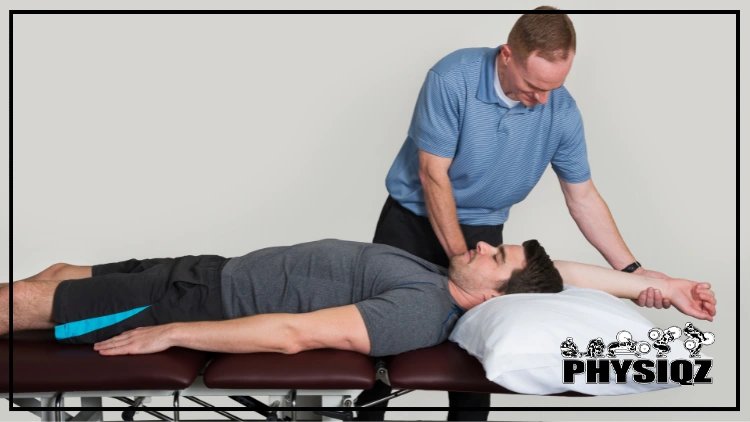
If you’re struggling with tight lats symptoms, including back and shoulder pain, or general stiffness and tightness, this article will help anyone dealing with this issue learn the antomy of the lats and specific symptoms before moving on to a full on diagnosis tutorial.1
Once you determine whether or not you have tight lats, we’ll explain the three key steps necessary for pain-free lats and how to utilize specific exercises, stretches, mobility work, trigger point release, dry needling, and other modalities to find complete relief from pain.
The good news is most issues can be solved with home exercises and occasional over-the-counter pain relievers.2
An Overview of Lat Anatomy
To understand the various symptoms of tight lats, it’s important to understand the muscles themselves.
As the broadest muscles in the back, the lats attach to the pelvis, the mid spine, and the upper arms!
This makes the lats both a back muscle and an upper arm muscle. You’ll find them prominently featured in the muscles that do deadlift work.
The lats’ primary roles include:
- Adducting the arms toward the body
- Internally rotating the arms
- Extending the shoulders
The pecs are a synergistic muscle to the lats, meaning they play the opposite role in movements.
It follows that when the lats are tight, it becomes difficult to perform overhead movements with good form. Additionally, the shoulders will struggle to externally rotate.
Tight Lats Symptoms
Symptoms of tight lats can range from a tight feeling or stiffness, and dull to excruciating pain.
Both the tightness and pain may be felt in the following areas:
- Upper back
- Mid-back
- Middle of the back, between the scapula or shoulder blades
- Underneath the arm pit
- Neck
- Shoulder
Oftentimes these symptoms can be triggered by reaching the arms overhead or forward, but bringing the elbows down or simply slouching can also trigger symptoms.
Due to their size and many attachments, pictured below, tight lats can also contribute to low back pain, abdominal muscle pain, and rib muscle pain as well. If their relationship with the trapezius muscles is compromised due to tightness, even neck pain may result.
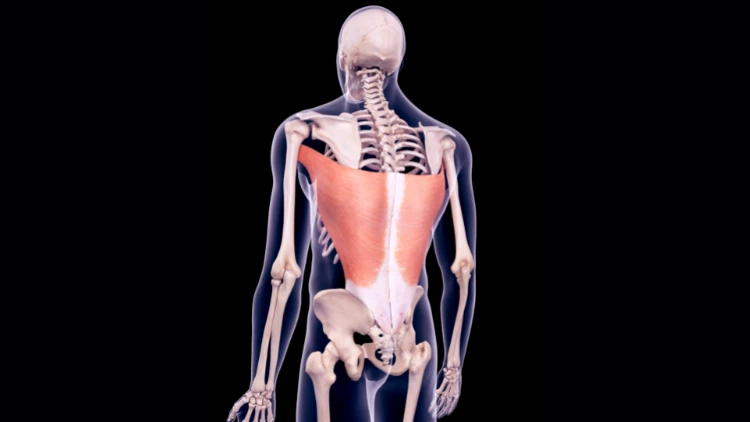
Source: Science Photo Library via Canva.com3
Do You Have Tight Lats? What Are the Tight Lats Symptoms? (Try This Tight Lat Diagnosis Test)
If you’re unsure if upper lat muscle tightness is causing pain, try this simple diagnostic test!
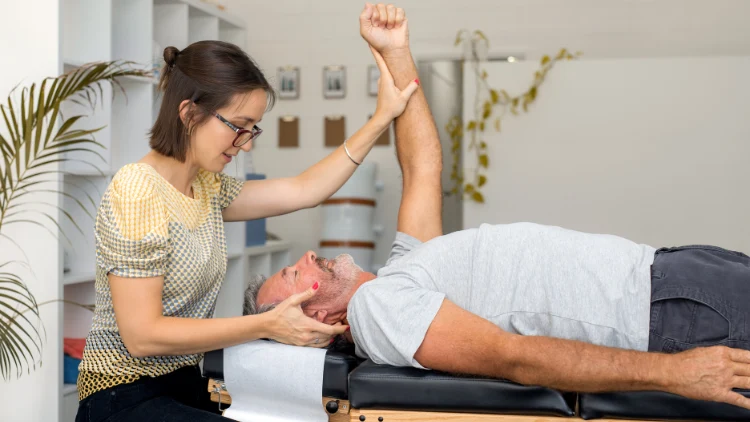
Source: Natalie Maro via Canva.com4
This image illustrates proper hand, arm, and elbow positioning for the test.
Take a picture or video of your test before implementing the treatment program described below, then try the test again later to measure progress.
Step 1: Lie flat on a bed or couch while wearing a tank top or nonrestrictive shirt.
Step 2: Slowly reach the arms overhead. Point the pinkie fingers toward the ceiling and try to keep the arms shoulder distance apart and the elbows as straight as possible.
Do not allow the spine to arch away from the bed or couch.
Step 3: Stop when the elbows begin to bend or the arms move further than shoulder distance apart.
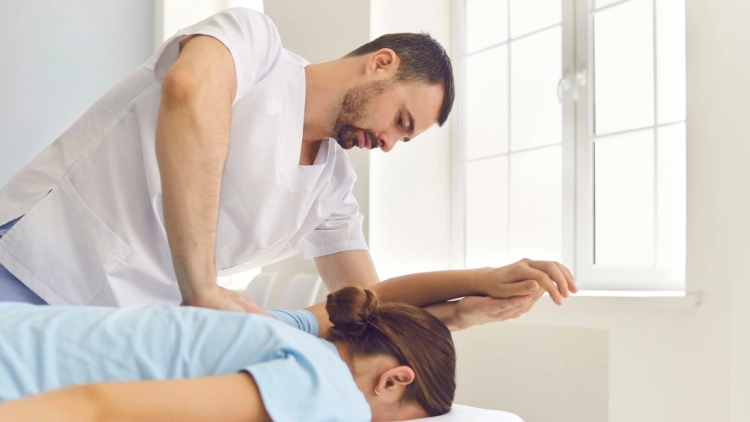
Source: studioroman via Canva.com5
This image shows the position the arms are likely to drift towards if the lats are tight.
If you’re unable to bring the arms flush with the couch or bed without bending the elbows or moving the arms apart, your lats are likely tight.
Keep in mind that chronic low back pain and weak glutes are other common indicators of tight lats.6 This back squat workout can help improve glute strength.
Do Tight Lats = Shoulder Pain? Why Do Tight Lats Cause Shoulder Pain? (Tight Lats Symptoms)
Since they attach to the upper arm bones, tight lats can cause debilitating shoulder pain. They may place the shoulders in an overly internally rotated position, which increases pressure on the front of the shoulder joints and makes overhead pressing and externally rotated shoulder movements more likely to cause injury.
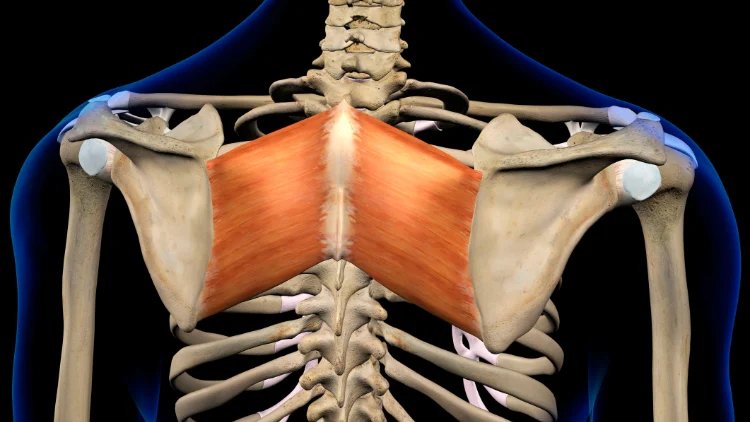
Source: Hank Grebe via Canva.com7
Tight lats can also be responsible for a dull, generalized aching feeling in the mid-back between the shoulder blades. This is because tight lats can place the scapula in a suboptimal position during daily activities.
This walkthrough for self-diagnosing shoulder pain and nine exercises for rehabilitation to alleviate it guide can be a helpful tool in eliminating other potential causes of shoulder pain. Keep in mind, too, that stress levels can contribute to chronic muscle pain.8
Poor Posture
Beside the tight lats shoulder pain correlation, there are other symptoms of tight lats that can majorly decrease quality of life. Most of us have seen lifters with ‘caveman’ posture – their shoulders slump forward, the backs of their hands rotate forward when they’re standing, and they may slip into a forward head carriage.
Not an attractive look! Tight lats can easily pull the upper arm bones into this unfortunate position.
Weakness & Overcompensation
When a huge muscle like the lats gets tight, other, smaller muscles are often forced to overcompensate, especially in exercises that demand a bigger range of motion like an overhead press. As these other muscles take over, the lats become weaker.
This vicious cycle can be hard to break out of once it’s been established by months or even years of workouts. When smaller shoulder muscles are required to do a job that’s designed for a large muscle like the lats, injury often ensues.
Partial Range of Motion
As the diagnostic test above illustrated, tight lats place serious limitations on shoulder and spinal movement. This partial range of motion is bad news for anyone who wants to get the most out of their workouts.
The experience of tight lats is similar to the feeling of wearing a dress shirt that’s too tight. Imagine trying to workout in that kind of shirt – exercise performance would certainly suffer.
3 Easy Steps To Cure Latissimus Dorsi Pain
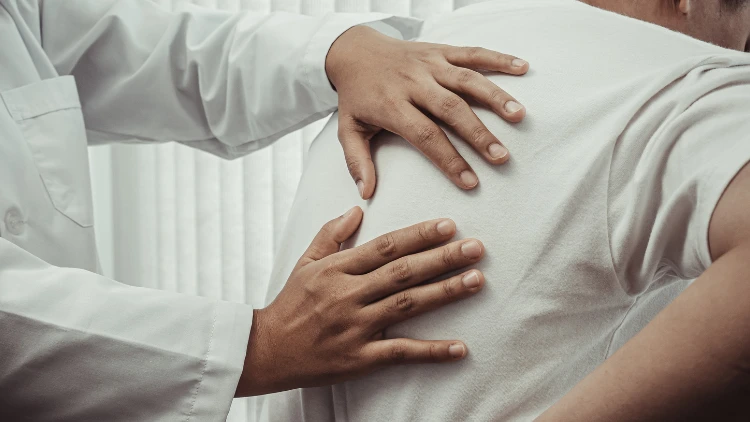
Source: superohmo via Canva.com9
While these tight lats symptoms can be scary, treatment options abound. Follow these three steps in order until the lats respond positively.
Keep in mind that a combination of modalities will likely be the best solution.
#1. Get Your Stretch On
While research indicates that all types of stretching are effective to increase range of motion, mixing up a stretching routine is often a good idea.10 Check out these ideas from mobility experts and yoga instructors and be sure to stretch everyday for at least a few minutes.
General Lower & Upper Lat Stretches
Wall Lat Stretch: Stand next to a power rack with the right hip toward the rack. Step the left foot behind the right foot.
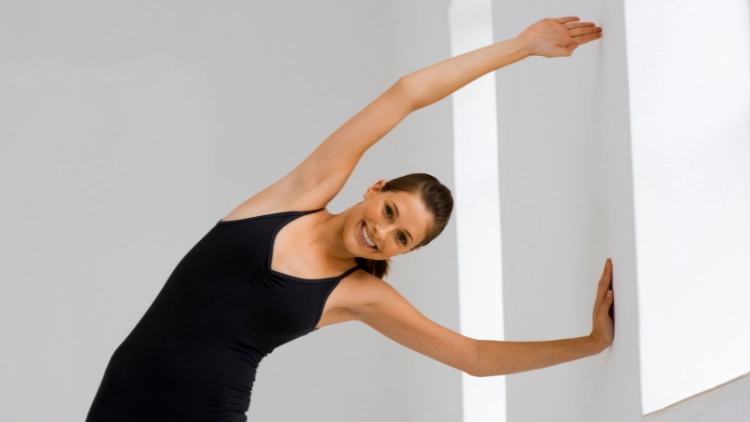
Source: Pixland via Canva.com11
Reach the left arm overhead and grab the rack with the thumb facing up. Begin to lean into a side bend, using the right hand to help maintain balance.
Lean as far as possible without shifting the feet, then hold. Complete 3 sets of 20-30 seconds on each side.
Lat Stretch Band Exercise: Loop a Crossfit-style band through itself over the top rung of a power rack. Hold the band in the left arm, then rotate to face away from the rack.
Step the left foot forward into a lunge position. Keep the low back rounded while leaning forward and allowing the band to stretch the arm back.
Keep the left thumb pointing toward the back wall throughout. Complete 3 sets of 10-20 second holds on each side.
Mobility Work for Tight Lats
Single Arm Overhead Supported Stretch: Place the left hand palm-side up on a waist high table. Use the right hand to hold the left hand in place while hinging at the hips.
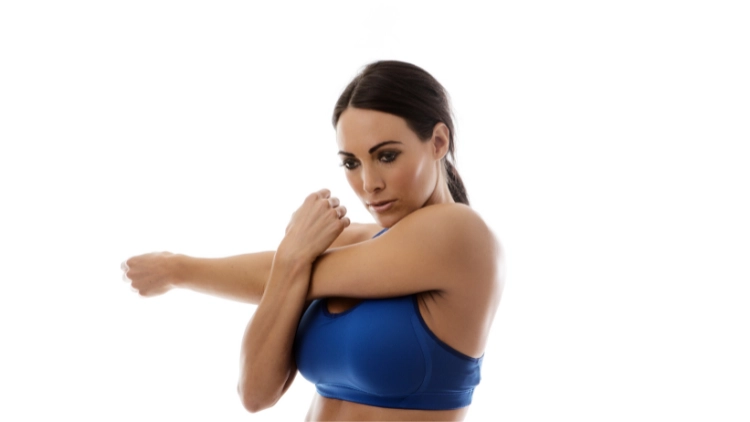
Source: jayfish via Canva.com12
Keep the spine and the arms straight as the chest sinks toward the floor. Use the right hand to keep the left hand and shoulder in external rotation.
Hold for 3 sets of 30 seconds on each side.
Broomstick Overhead Stretch: Hold a broomstick or PVC pipe in both hands. Be sure the hands are shoulder distance apart.
Place the broomstick or pipe on a firm waist high surface, with the backs of the hands down. Send the hips back and hinge until the spine and arms are parallel with the floor.
Drop the chest and head toward the floor. Complete 3 sets of 30 second holds, moving the hands a little bit wider with each set.
Behind the Head Squat Stretch: Hold a broomstick or PVC pipe behind the back as if setting up for a back squat. Lower into a squat in front of a firm waist high surface until the elbows reach the surface.
Brace the broomstick or PVC pipe against the back of the head and lower into the squat as much as possible, keeping the hands facing toward the ceiling. Hold for 3 sets of 30 seconds.
Yoga for Muscles Around Armpit (the Lat)
Downward Facing Dog: This popular yoga pose is a great way to address symptoms of tight lats. Focus on keeping the spine as straight as possible and lining the upper arms up with the ears.
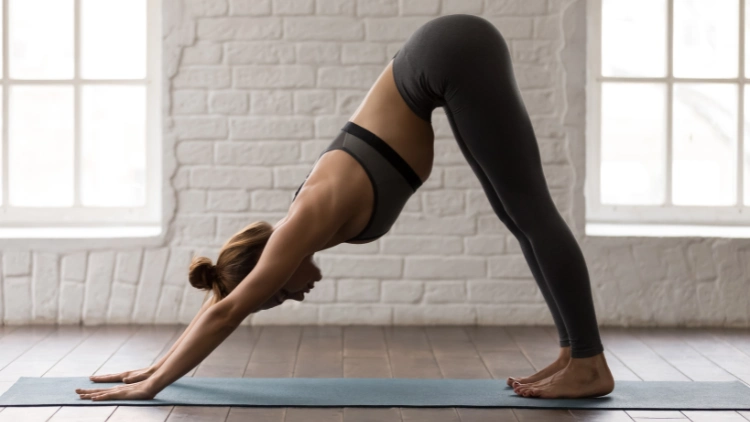
Source: fizkes via Canva.com13
It might be necessary to bend the knees or lift the heels away from the floor to keep the emphasis on the lats. Work up to holding this posture for 1-2 minutes each day.
Gate Pose with Side Bend: Kneel on the right knee and extend the left leg out to the side. Move the spine into a side bend, placing the left hand on the left leg for support.

Image by serhii_bobyk on Freepik14
Stretch the right arm overhead to the left, rotating the right palm toward the floor. Hold for 30 seconds on each side.
#2. Learn the Technique for Latissimus Dorsi Trigger Point Release (Myofascial Release)
Use a lacrosse ball, therapy ball, foam roller, or massage gun to target the lat muscles for an intense trigger point release. These methods target the fascia, or the thick membranes that cover the muscles, and can help ease tension in muscle knots, also known as trigger points.
Lacrosse Ball, Therapy Ball, or Foam Roller
Find a side lying position on the floor with the ball or foam roller underneath the armpit closest to the floor. Using the legs and free arm for support and repositioning, roll around until appropriate pressure is placed on the trigger point in the lat muscles facing the floor.

Source: microgen via Canva.com15
Hold pressure on the trigger point for 20-30 seconds. Switch sides, then repeat two more rounds on each side.
Latissimus dorsi trigger point release shouldn’t feel excruciating, but it might not feel comfortable.
Massage Gun
Use a massage gun to target trigger points and muscle knots in the lats – it may be necessary to ask a friend or family member for help. Aim for 10-15 minutes each day.
#3. Get the Professionals Involved (Benefits of Physical Therapy, Dry Needling, Massages etc.)
Finally, persistent tight lats might require treatment from a professional. Physical therapists, massage therapists, trigger point therapists, personal trainers, chiropractors, and myofascial release therapists each specialize in different treatment modalities and each type of treatment offers unique benefits.
Physical Therapy
Research shows that physical therapy can significantly improve back pain.16 A knowledgeable physical therapist will be able to recognize suboptimal movement patterns and prescribe specific exercises designed to correct muscular imbalances.
Massage Therapy
Many studies indicate that massage therapy can reduce pain and improve both mood and quality of life.17 A therapeutic massage will increase blood flow to the lats and help the muscles release unnecessary tension.
Just be sure to communicate with the therapist that you’re looking for lat-specific treatment.
Trigger Point Therapy
A professional who specializes in trigger point therapy may use dry needling, trigger point injections, or physical manipulation to help release trigger points, often referred to as ‘muscle knots’. This type of therapy often provides breakthroughs for people who have tried everything else.
Personal Training
Personal trainers can prescribe stretches and exercises to improve lat function.
They also provide the invaluable resource of in-person movement assessment, helping lifters improve their form and get more from the exercises they’re already doing.
Chiropractic Care
Chiropractic adjustments can help realign ribs, shoulders, and spinal vertebrae that have been shifted out of place by tight lats.
Myofascial Release Therapy
Some chiropractors, physical therapists, and massage therapists specialize in myofascial release, a manual therapy that focuses on the myofascial tissue that wraps around and supports muscles. It utilizes gentle, sustained stretching that can help reduce inflammation and improve muscle health.
Why Tight Lats Are a Common Issue
While these approaches above can help alleviate most pain and symptoms, it’s important to consider why tight lats are a common issue to be sure you don’t go through this issue again.
- 1. Lats Are the Largest Upper Body Muscle & Have a Cascading Effect on Posture
Gym rats tend to fixate on the muscles they can easily see when they look in the mirror, including the pecs, biceps, and shoulder muscles. It’s easy to forget that the lats are the largest muscle in the upper body!
As a consequence, any imbalances or issues in the lats will cause a ripple effect into other parts of the body, leading to pain, poor posture, and overcompensation by other muscles. Lifters should regularly review their training plans to ensure that they are prioritizing the development of strength in primary movers like the lats and glutes.
Don’t worry, though – the lats are not the hardest muscle to grow.
- 2. Many Lifters’ Lats Are Weak and Underdeveloped
Push-ups come more easily to most people than pull-ups and pull downs. This speaks to a general tendency towards underdeveloped lats and overdeveloped chests.
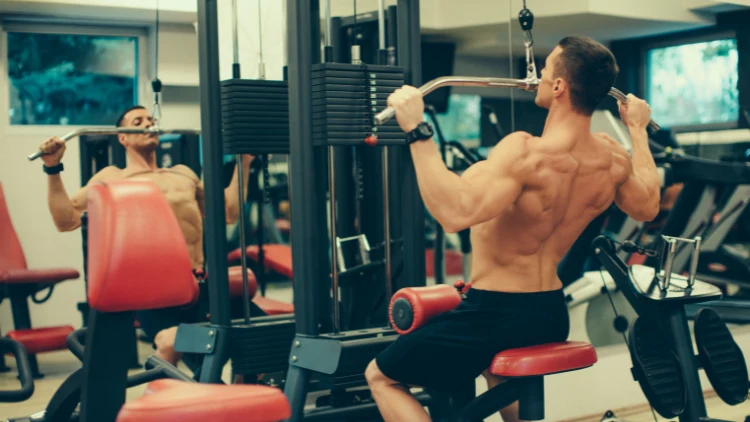
Source: eclipse_images via Canva.com18
Perhaps counterintuitively, weak lats are often painful, tight lats. By focusing on upper back and posterior chain training, however, lifters can rectify any muscle imbalances.
For lifters who deadlift regularly, read where should you feel deadlifts and focus on lat activation in this popular compound movement.
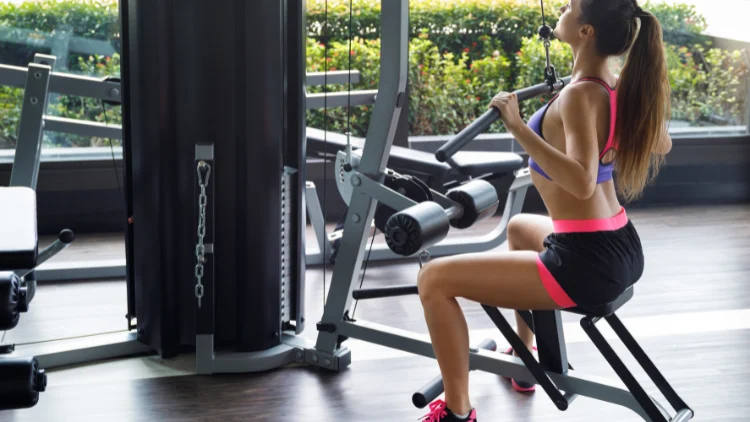
Source: A’s Images via Canva.com19
- 3. Stretching the Lats Can Be Confusing
Finally, while stretching some muscle groups, like the hamstrings, feels like a no-brainer, many people don’t know how to stretch the lats. The muscles around the armpit are complex and may require creativity (and some special equipment) to stretch effectively.
Fortunately, the best lat stretches and how to do them correctly are listed above.
While tight lats can cause far-reaching problems in both the gym and daily life, treating them by yourself is possible and worse case scenario, the types of medical providers above can help tackle the problem with their various approaches.
Focus on applying the variety of treatment options described here, and soon tight lats symptoms will be a thing of the past.
Frequently Asked Questions
Can Strength Training Cause Pain in the Latissimus Dorsi?
Strength training can theoretically cause pain in any muscle group, particularly if lifters choose movements or weights that are inappropriate for their skill level. If strength training is leading to lat pain, scale back on weights and reps and focus on an adequate warm-up, good form, and rock solid recovery techniques.
This 21 day no junk food challenge can help improve diet quality, which may alleviate pain-causing inflammation.
Do Tight Lat Muscles Cause Bad Posture? Or Does Bad Posture Cause Tight Lat Muscles?
This is a chicken or egg conundrum and the answer will be different for different people, dependent on anatomy, exercise history, and injuries. Regardless, working to improve Tight lat muscles can improve posture and vice versa.
Do Tight Lat Muscles Cause Rib Pain?
The lats attach to the bottom four ribs and assist in many movements that involve the rib cage, so this is definitely possible. However, it’s wise to look into the possibility of intercostal muscle strain or rib subluxation as well.
What Are the Symptoms of Weak Lats?
People with weak lats will struggle to maintain good posture, find overhead and horizontal pulling motions difficult, and may experience shoulder pain and injury due to muscular imbalances. When planning remedial workouts, be sure to consider the best time to exercise to lose belly fat.
Do Tight Lat Muscles Cause Rounded Shoulders?
While a variety of factors can lead to rounded shoulders, including tight chest muscles, repeated postural habits, and general spinal health and positioning, tight lat muscles can also cause the upper arms to internally rotate unnecessarily, which contributes to the appearance of rounded shoulders.
Are Tight Lat Muscles Due to a Weak Serratus?
The serratus anterior is a fan-shaped muscle that wraps below the armpits and protracts the shoulder blades. If this muscle is unusually weak, it may contribute to compensation and tightness is the nearby lat muscles.
Can Tight Lat Muscles Cause Difficulty in Breathing?
Surprisingly, the lats are a respiratory accessory muscle. When they are tight or otherwise not functioning correctly, the lungs will struggle to expand appropriately and breathing may feel more difficult.
Are Tight Lat Muscles Symptoms Debilitating?
Generally speaking, tight lat symptoms and the associated pain isn’t debilitating but there can be rare instances where the main and lack of mobility can impair a person’s daily life. If your lat symptoms are becoming an issue in day to day life, stop where you’re at and find a sports physical therapist immediately to improve your quality of life.
References
1leezsnow. Canva. Accessed 16 April 2023. <https://www.canva.com/photos/MAEE3qJzUao-upper-extremity-pnf-resistance-exercise-in-physical-therapy/>
2El-Tallawy, S. N., Nalamasu, R., Salem, G. I., LeQuang, J. A. K., Pergolizzi, J. V., & Christo, P. J. (2021). Management of Musculoskeletal Pain: An Update with Emphasis on Chronic Musculoskeletal Pain. Pain and therapy, 10(1), 181–209. <https://doi.org/10.1007/s40122-021-00235-2>
3Science Photo Library. “F017/1255.” Canva, 20 April 2019. Accessed 13 April 2023. <https://www.canva.com/photos/MADq3vbyn-k-f017-1255/>
4Natalie Maro. “Senior Man Having Chiropractic Adjustment.” Canva. Accessed 13 April 2023. <https://www.canva.com/photos/MAEN98RYZrs-senior-man-having-chiropractic-adjustment/>
5studioroman. “Young Doctor Specialist Curing Client’s Back and Shoulders in Modern Health Center.” Canva. Accessed 13 April 2023. <https://www.canva.com/photos/MAELsSNkERA-young-doctor-specialist-curing-client-s-back-and-shoulders-in-modern-health-center/>
6Mohamed, R. R., Abdel-Aziem, A. A., Mohammed, H. Y., & Diab, R. H. (2022). Chronic low back pain changes the latissimus dorsi and gluteus maximus muscles activation pattern and upward scapular rotation: A cross-sectional study. Journal of back and musculoskeletal rehabilitation, 35(1), 119–127. <https://doi.org/10.3233/BMR-200253>
7Hank Grebe. “Male Rhomboid Major Back Muscles in Isolation on Skeleton.” Canva. Accessed 12 April 2023. <https://www.canva.com/photos/MAD9YMm5tt4-male-rhomboid-major-back-muscles-in-isolation-on-skeleton/>
8Gregory, N. S., & Sluka, K. A. (2014). Anatomical and physiological factors contributing to chronic muscle pain. Current topics in behavioral neurosciences, 20, 327–348. <https://doi.org/10.1007/7854_2014_294>
9superohmo. “Physiotherapist working examining treating injured back.” Canva. Accessed 13 April 2023. <https://www.canva.com/photos/MAEyKqAq33E-physiotherapist-working-examining-treating-injured-back/>
10Page P. (2012). Current concepts in muscle stretching for exercise and rehabilitation. International journal of sports physical therapy, 7(1), 109–119. <https://www.ncbi.nlm.nih.gov/pmc/articles/PMC3273886/>
11Pixland. “Woman stretching on wall.” Canva. Accessed 13 April 2023. <https://www.canva.com/photos/MAC78y8QVA4-woman-stretching-on-wall/>
12jayfish. “stretching arms.” Canva. Accessed 13 April 2023. <https://www.canva.com/photos/MADBxCH46v4-stretching-arms/>
13fizkes. “Woman practicing yoga, Downward facing dog, adho mukha svanasana.” Canva. Accessed 13 April 2023. <https://www.canva.com/photos/MADmgOfnDiM-woman-practicing-yoga-downward-facing-dog-adho-mukha-svanasana/>
14Freepik. Accessed 16 April 2023. <https://www.freepik.com/free-photo/happy-woman-exercising-studio-smiling-cheerfully-while-stretching_9437441.htm?query=woman%20bending#from_view=detail_alsolike>
15microgen. “Foam Roller.” Canva, 13 December 2011. Accessed 13 April 2023. <https://www.canva.com/photos/MADnCt6UKms-foam-roller/>
16Sahin, N., Karahan, A. Y., & Albayrak, I. (2017). Effectiveness of physical therapy and exercise on pain and functional status in patients with chronic low back pain: a randomized-controlled trial. Turkish journal of physical medicine and rehabilitation, 64(1), 52–58. <https://doi.org/10.5606/tftrd.2018.1238>
17Crawford, C., Boyd, C., Paat, C. F., Price, A., Xenakis, L., Yang, E., Zhang, W., & Evidence for Massage Therapy (EMT) Working Group (2016). The Impact of Massage Therapy on Function in Pain Populations-A Systematic Review and Meta-Analysis of Randomized Controlled Trials: Part I, Patients Experiencing Pain in the General Population. Pain medicine (Malden, Mass.), 17(7), 1353–1375. <https://doi.org/10.1093/pm/pnw099>
18eclipse_images. “Lat pulldowns.” Canva, 16 November 2008. Accessed 13 April 2023. <https://www.canva.com/photos/MAEJMbseqgI-lat-pulldowns/>
19A’s Images. “Woman Doing Exercise for Her Back – Lat Pulldown.” Canva. Accessed 13 April 2023. <https://www.canva.com/photos/MAE3KwdSRIk-woman-doing-exercise-for-her-back-lat-pulldown/>